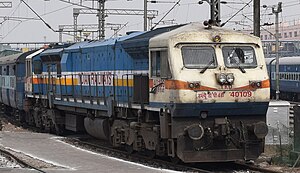
The SD80MAC was a 5,000 horsepower (3.7 MW) C-C diesel-electric locomotive. It was powered by a 20-cylinder version of EMD's 710G prime mover, and was the second diesel locomotive by GM-EMD to use a V20 engine, since EMD's SD45 series. It introduced a wide radiator housing similar to GE Transportation locomotives and the placement of dynamic brakes at the rear of the locomotive, which is a quieter location, features that were incorporated into the SD90MAC and SD70ACe models. Key spotting differences between the SD80MAC and SD90MAC include no external rear sandbox on the SD90MAC, no rear lighted number boards on the SD90MAC, and the placement of the front numberboards. The SD80MAC also had recessed red marker lights in the nose, an identifying feature unique to Conrail (CR) locomotives, although Norfolk Southern (NS) had removed the lights on most of their former Conrail engines.
The Indian locomotive class WDM-2 is a class of diesel-electric locomotive that was developed in 1962 by American Locomotive Company (ALCO) for Indian Railways. The model name stands for broad gauge (W), Diesel (D), Mixed traffic (M) engine, 2nd generation (2). They entered service in 1962. A total of more than 2,700 WDM-2 was built at ALCO and Banaras Locomotive Works, Varanasi between 1962 and 1998, which made them the most numerous class of mainline diesel locomotive until its successor the WDM-3A.
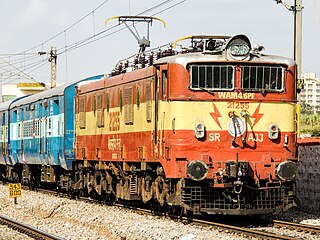
The Indian locomotive class WAM-4 is a class of 25 kV AC electric locomotives that was developed in 1970 by Chittaranjan Locomotive Works for Indian Railways. The model name stands for broad gauge (W), alternating current (A), mixed traffic (M) locomotive, 4th generation (4). They entered service in March 1971. A total of 500 WAM-4 were built at CLW between 1970 and 1983, which made them the most numerous class of mainline electric locomotive till its successor the WAG-5.

The Indian locomotive class WDG-4 is a type of six-axle (Co-Co) freight-hauling diesel-electric locomotive with AC electric transmission designed by General Motors Electro-Motive Diesel in 1997–1998 for Indian Railways, where they are classed as WDG-4. Derived from the EMD SD70MAC, it is powered by a 4,000 hp (3,000 kW) 16-cylinder EMD 710G3B prime mover. Thirteen were built by EMD as order #958647, and a further eight were exported in kit form and assembled in India. The class entered service in 1999. This locomotive is also famous for, and can be identified by the distinct Jet Aeroplane-like sounding capability of its EMD 710 prime mover.
The ALCO DL560C is a series of diesel-electric locomotive with AC electric transmission designed by the American Locomotive Company and produced under license by Banaras Locomotive Works (BLW) Varanasi, India for Indian Railways as their classes WDM-2, WDM-3A/2C, WDM-3D and WDG-3A for operation in India. The locomotive is fitted with a 16-cylinder ALCO 251 B,C diesel engine. In the early 1960s Indian Railways needed a reliable diesel workhorse to gradually replace its steam locomotive fleet. Equal numbers of ALCO's DL560C and EMD's G16 were chosen for trials. More locomotives of each of these were purchased for more trials. Indian Railways was keen on producing these locomotives in the country rather than depending on imports. EMD did not agree for a Transfer-of-Technology, while ALCO did. Thus ALCO DL560C was chosen for the job due to its easy maintenance, reliability and simple operation. And from then on vast numbers of this loco in different configurations have been produced and remain the main diesel traction power of Indian Railways.

The EMD GT26 Locomotive Series made their debut in 1967 after the rise in popularity of the American EMD SD40. Designed to meet most First World, Second World and Third World countries, the GT26 Series were now equipped with a turbocharged high horsepower EMD 645 Series engine as well as six axle HT-C trucks to provide better traction effort at slow speeds. Based on customer input, the GT26 Series would be defined by various designations that suit the customer's railway operations.
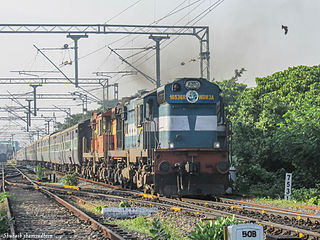
The Indian locomotive class WDM-3A is a class of diesel–electric locomotive that was developed in 1993 by Banaras Locomotive Works (BLW), Varanasi for Indian Railways. The model name stands for broad gauge (W), Diesel (D), Mixed traffic (M) engine, with 3300 horsepower (3A). The WDM-3A is a later classification of earlier WDM-2C. They entered service in 1994. A total of 143+ were built at ALCO and Banaras Locomotive Works between 1994 and 2003 with rest of the 1246 units being rebuilt from WDM-2 which made them the most numerous class of mainline diesel locomotive until the WDG-4.

The Varanasi–Jaunpur City–Sultanpur–Lucknow line is a railway line connecting Varanasi and Lucknow, both in the Indian state of Uttar Pradesh. This line is under the administration of Northern Railway and Lucknow Charbagh Divisions.

The class YDM-4 is Indian Railways' workhorse diesel locomotive. The first units were imported fully built from the American Locomotive Company (Alco) in 1961. Since 1968, it has been manufactured in India by the Banaras Locomotive Works (BLW), Varanasi. The model name stands for metre gauge (Y), diesel (D), mixed traffic (M) engine. The YDM-4 has been the most successful diesel locomotive in the metre gauge operation of Indian Railways. The YDM-4A is a variant of the YDM-4 supplied by MLW. Originally equipped with vacuum brakes. Some were later equipped with dual brakes, particularly those working in the Northeast Frontier Railway were retrofitted with dual brake system by Lumding shed. The YDM-4 locos have a maximum speed of 100 km/h (62 mph), restricted to 85 km/h (53 mph).
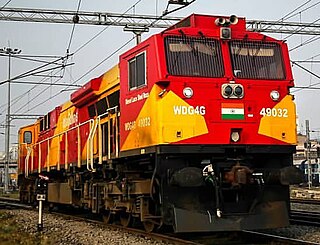
The Indian locomotive class WDG-4G is a class of dual-cabin freight-hauling diesel-electric locomotive used by the Indian Railways (IR). The locomotive is designed by GE Transportation and is based on its Evolution Series, which are used in North America. The class is meant for freight hauling and replaces the older American Locomotive Company (ALCO)-designed locomotives, which have been the mainstay diesels of Indian Railways since 1962. Equipped with a 12-cylinder fully turbocharged GEVO engine, it is claimed to be 50% more environmentally friendly than its predecessors and is the first in the country to be compliant with level one of the emission norms set by the International Union of Railways (UIC-1). The locomotive has two cabs for easy reversal, both of which are air conditioned.

The Indian locomotive class WDM-3D is a class of diesel-electric locomotive that was developed in 2003 by Banaras Locomotive Works (BLW), Varanasi for Indian Railways. The model name stands for broad gauge (W), Diesel (D), Mixed traffic (M) engine with 3300 horsepower (3D). The engine is classified WDM-3D though it outputs only 3300 hp and not 3400 hp as the name should suggest. They entered service in 2003. A total of 590+ WDM-3D were built at Banaras Locomotive Works (BLW), Varanasi between 2003 and 2016.

The Indian locomotive class WDP-1 is a class of diesel-electric locomotive that was developed in 1995 by Banaras Locomotive Works (BLW) for Indian Railways. The model name stands for broad gauge (W), Diesel (D), Passenger traffic (P) engine, 1st generation (1). They entered service in 1995. A total of 69 WDP-1 units were built at Banaras Locomotive Works (BLW), Varanasi between 1995 and 1999.

The Indian locomotive class WDP-3A, colloquially nicknamed the Toaster, is a class of diesel-electric locomotive that was developed in 1998 by Banaras Locomotive Works, Varanasi for Indian Railways. The model name stands for broad gauge (W), Diesel (D), Passengers traffic (P) locomotive with 3100 horsepower (3A). The WDP-3A is a later classification of earlier WDP-2. They entered service in 1998. A total of 44 were built between 1998 and 2001.
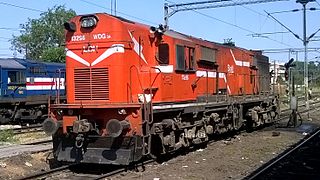
The Indian locomotive class WDG-3A is a class of diesel-electric locomotive that was developed in 1994 by Banaras Locomotive Works (BLW),Varanasi for Indian Railways. The model name stands for broad-gauge (W), Diesel (D), Goods traffic (G) engine, 3,100 hp (3A) locomotive. They entered service on 18 July 1995. A total of 1,164 WDG-3A units were built between 1994 and 2015 at BLW, Varanasi with a few units being produced by Diesel Loco Modernisation Works (DLMW) and Parel Workshop.
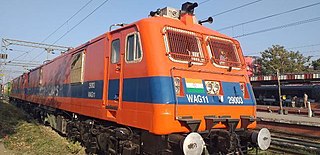
The Indian locomotive class WAG-11 is a class of twin-section 25 kV AC electric locomotives that was developed in 2018 by Banaras Locomotive Works (BLW), Varanasi for Indian Railways. This freight engine has been designed for 105-km/hourspeed and weighs 252 tons. It is equipped with three-phase induction motor,four power converters and regenerative as well as pneumatic braking system. The model name stands for broad gauge (W), Alternating Current (A), Goods traffic (G), and 11th in series (11). They entered trials service in 2019. A total of 4 WAG-11 pairs have been built by Banaras Locomotive Works (BLW), Varanasi.

The Indian locomotive class YDM-5 is a class of diesel-electric locomotive that was developed in 1964 by General Motors (GM-EMD) for Indian Railways. The model name stands for Metre gauge (Y), Diesel (D), Mixed traffic (M) engine, 5th generation (5). They entered service in 1964. A total of 25 YDM-5 locomotives was built between 1963 and 1964.
The Indian locomotive class YDM-3 is a class of diesel-electric locomotive that was developed in 1964 by GM-EMD for Indian Railways. The model name stands for Metre gauge (Y), Diesel (D), Mixed traffic (M) engine, 3rd generation (3). They entered service in 1962. A total of 30 YDM-3 locomotives was built between 1961 and 1962.

The Indian locomotive class WDG-5 is a class of heavy haul Diesel-electric locomotive built by Banaras Locomotive Works, Varanasi in collaboration with Electro-Motive Diesel. At a rated power output of 5,500 horsepower (4,100 kW), it is the second most powerful diesel locomotive class on Indian Railways, just out-powered by the 6,000 horsepower (4,500 kW) WDG-6G. Derived from the EMD SD80MAC, it was meant as a direct upgrade to the WDG-4 aka GT46MAC. The locomotive series is named Bheem, after the strong Pandav brother from epic Mahabharata. The loco has the 2-stroke Turbocharged EMD 20N-710G3B-ES of the EMD SD80MAC and an AC-AC transmission. Since the loco has been developed by installing a v20-710 prime mover and replacing the standard v16 in the WDG4 GT46MAC locomotive, the model was re-designated by adding 4 to the predecessor model, with GT-46 becoming GT-50, owing to the number of cylinders going from 16 to 20, thereby making it the First EMD locomotive in the GT-series to use a v20-710 engine.
The WDM-2G is a class of diesel electric genset locomotive used in Indian Railways. It is one of the rarest locomotives in India with only two units being produced by Patiala Locomotive Works (PLW). The locomotives were produced with an intention of being fuel efficient and to be used for light to medium duties such as short passenger runs along with occasional shunting. They are one of the only two classes of locomotives in India to feature multiple prime movers, the other example being WDS-6G, which was designed solely for shunting. They have a rated power of 2,400 HP.
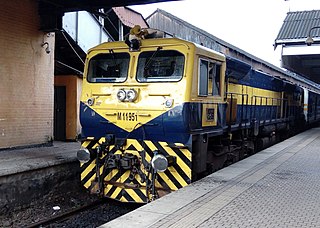
Class M11 is a mainline diesel-electric locomotive built by Banaras Locomotive Works, India, for use on Sri Lanka Railways and first delivered in 2018. This locomotive, clearly with its look, was developed from the WDG-4D locomotive of the Indian Railways, which is originally of 4,500 HP, as it uses a 16-cylinder variant of the EMD 710 prime mover. The HP was Down-tweaked to 3,000 using a 12-cylinder variant of the same engine, making it look and sound similar to British/European Railways' popular Class 66 EMD locomotive, but with AC-AC traction.
